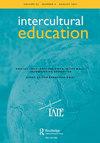Interculturalism, ethnicity, and multilingualism in upper secondary school: an analysis of social pedagogical identities during pedagogical work with newly arrived students in Sweden
IF 0.8
Q3 EDUCATION & EDUCATIONAL RESEARCH
引用次数: 2
Abstract
ABSTRACT The aim of the present study is to attain new knowledge about interculturalism, ethnicity, and multilingualism in the upper secondary school context in conjunction with pedagogical work with students who are newly arrived in the country. The empirical material for the study was collected in the upper secondary context in Sweden and consists of documents, field notes, and qualitative interview. Analysis shows that a distance relationship is created and recreated in the interactive flow between the newly arrived students and the teachers' institution when ethnic social pedagogical monitoring and control are represented in writing by the institution (the upper secondary school) and verbally in the observed and recounted situations. Social pedagogical identities are produced and reproduced in the interactive dynamic, in which the newly arrived student is represented as a successful student, developing in the social pedagogical meaning. However, the newly arrived student also is represented as a humiliated, weary, excluded student who, through demonstration of moral dissolution, displays an ethnified victim student identity that is in opposition to the teachers and institution. This represented humiliation, weariness, and exclusion of the newly arrived student constructs and reconstructs the image of a disadvantaged student. The effect is likely a negative impact on the aims of the upper secondary school to include and integrate newly arrived students into the school community and society at large.高中的跨文化、种族和多语性:对瑞典新来学生教育工作中社会教育身份的分析
本研究的目的是结合初来乍到的学生的教学工作,在高中背景下获得关于跨文化、种族和多语言的新知识。该研究的经验材料是在瑞典的高中背景下收集的,包括文件、实地笔记和定性访谈。分析表明,当学校(高中)以书面形式表示民族社会教学监控时,在观察和叙述的情况下,在新来的学生和教师机构之间的互动流程中,一种距离关系被创造和再创造。社会教学身份是在互动动态中产生和复制的,在互动动态中,新来的学生被代表为一个成功的学生,在社会教学意义上发展。然而,新来的学生也被描绘成一个被羞辱、疲惫、被排斥的学生,他通过道德解体的表现,表现出一种种族化的受害者学生身份,与老师和机构对立。这代表了对新来学生的羞辱、厌倦和排斥,重构了弱势学生的形象。这种影响可能会对高中的目标产生负面影响,高中的目标是让新来的学生融入学校社区和整个社会。
本文章由计算机程序翻译,如有差异,请以英文原文为准。
求助全文
约1分钟内获得全文
求助全文
来源期刊

Intercultural Education
EDUCATION & EDUCATIONAL RESEARCH-
CiteScore
2.30
自引率
8.30%
发文量
36
期刊介绍:
Intercultural Education is a global forum for the analysis of issues dealing with education in plural societies. It provides educational professionals with the knowledge and information that can assist them in contributing to the critical analysis and the implementation of intercultural education. Topics covered include: terminological issues, education and multicultural society today, intercultural communication, human rights and anti-racist education, pluralism and diversity in a democratic frame work, pluralism in post-communist and in post-colonial countries, migration and indigenous minority issues, refugee issues, language policy issues, curriculum and classroom organisation, and school development.
 求助内容:
求助内容: 应助结果提醒方式:
应助结果提醒方式:


